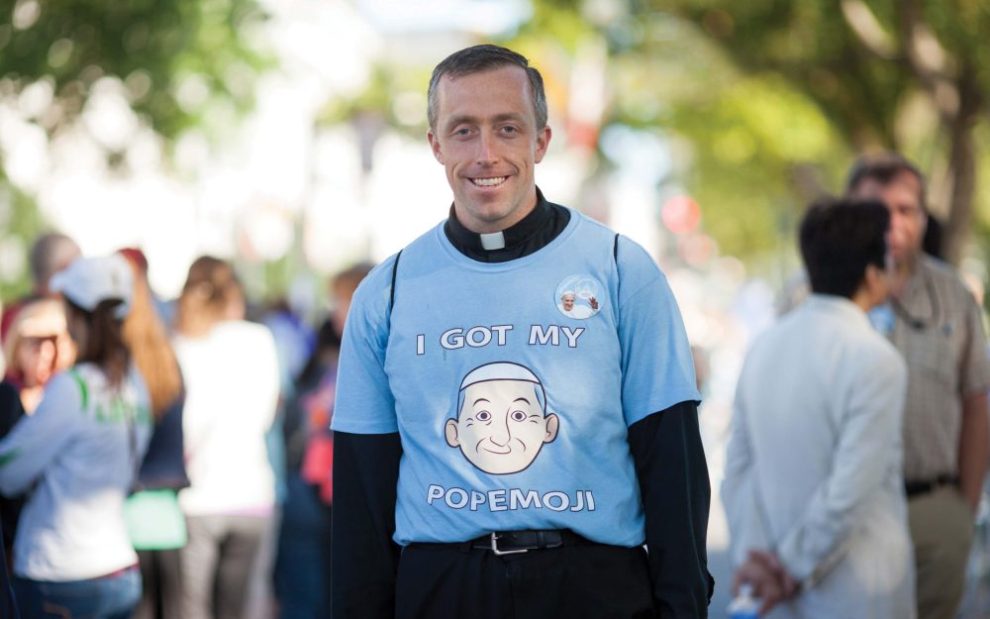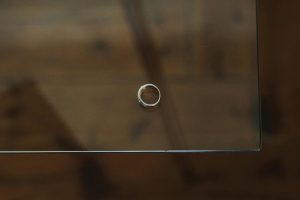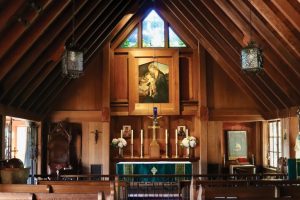Father Matthew Schneider had a “pretty normal Catholic upbringing,” he says. His family went to Mass on Sundays, he attended Catholic school, and he was an altar server. “I wasn’t always the best student in religion as a kid,” he says. “I was much more interested in dinosaurs than Jesus.”
Schneider was not very different from his young peers in this way. Growing up in Alberta, Canada, he never had much reason to think he was any different than other children. “I do recognize, looking back, that there were moments when I had missed social cues,” he says. “I understood things kind of squarely. Like when I was in first or second grade, the teacher said, ‘You can pray for whatever you want, and Jesus will give it to you.’ And I’m like, ‘Well, I want a Ferrari.’ ”
This “square” way of thinking lent itself well to academics. Schneider did well in school and went to a “learn at your own pace” high school that allowed him to move as quickly through lessons as he wanted. He started exploring his Catholic faith more deeply in high school, asking bigger questions. In college he pursued computer engineering and became heavily involved in campus ministry. In 2003, after hearing a speech by St. Pope John Paul II, Schneider felt called to the priesthood.
“Something just clicked,” he says. “I had a sense that God wanted me to be a priest.”
In 2013 Schneider was ordained. Immediately afterward he was assigned as a chaplain at a school. In this role he found his square thinking wasn’t as much of an asset. “It didn’t seem to work out after the first year,” he says. “I just wasn’t picking up on the kids’ social cues. It wasn’t a total disaster, but it just didn’t seem like the best fit.”
His superiors recommended he “get that checked out.” At age 34, Schneider was diagnosed with autism.
Coming out autistic
At first, Schneider was only open about his diagnosis with his superiors and immediate family. “I wasn’t really talking about it too broadly immediately,” he says. However, as he read more about his diagnosis, he noticed there was a missing link between neurodivergent people and the church.
“As I looked at how [autism] was dealt with in the church, I realized that there was a need [to talk about my diagnosis] in several respects,” he says. “So I started talking about it publicly.”
Schneider hoped that opening up about his diagnosis within the church would help other Catholics with autism. “I think it gets rid of some of the stigma,” he says. “I think it might be helpful for people who are autistic and other neurodivergent people . . . who are discerning religious life.” He says that if other neurodivergent people see people like themselves in these roles, their discernment process could be easier.
For Schneider, being open about his autism was not just about shattering stigmas. It was also about creating a comfortable environment for himself. He wanted his community to know that he was not intentionally being rude if he was direct. “One of the challenges we as autistics have is that sometimes we can come across as a little brusque, which can come across as rude,” he says. “Whereas if the other person knows you’re autistic, they might [understand].”
Schneider went public with his autism diagnosis on World Autism Day in 2019. At the time he was fairly well known in Catholic circles (thanks to a sizable Twitter presence) and knew that it would be better to address his diagnosis himself rather than allow the information to get leaked without him controlling his own story.
The announcement was met positively. Comments on Schneider’s video thank him for being a role model for children with autism. One mother even shared the excitement of her autistic son, who responded, “He’s like me! I’m autistic! And I’m Catholic!”
Awareness, acceptance, and inclusion
According to the Centers for Disease Control and Prevention (CDC), about 2.21 percent of adults in the United States have autism spectrum disorder, which the Diagnostic and Statistical Manual of Mental Disorders defines as involving “persistent deficits in social communication and social interaction” as well as “restricted, repetitive patterns of behavior.” It is a “spectrum” disorder because different people with autism will display various symptoms, from lacking general social skills to a delay or total lack of spoken language.
Despite making up a large part of the population, people with autism have not always been fully welcomed by the church. “In many places, there’s a stigma against all disabilities due to folk customs that see disabilities or neurodiversity as signs of sin and punishment rather than God-given opportunities for holiness of persons and their communities,” says Summer Kinard, a small press editor and owner, Christian education director, and homeschooling mother to five autistic children. She is also autistic.
“One of the best things any priest has ever said to me about our all-autistic family of seven (my husband, our five children, and me) is, ‘Never apologize to me about any of your children. God has called you here and wants them here,’ ” Kinard says.
Schneider agrees that parishes do not always know the best methods to include neurodivergent people. Lately, he has been working behind the scenes in parish communities (as well as writing a book and working on his doctorate in morality ethics) to locate the gaps in inclusivity.
“You can look at it as three levels to address what’s not happening and what needs to happen,” he says. “The first level is awareness, you know, not freaking out [over someone who is autistic].” Schneider says he thinks most parishes have accomplished this level, but the real challenge is moving beyond this awareness.
“Then you have acceptance, where we help the autistic kids or adults really take part in the liturgy and go through all the education to learn the faith, to live the faith,” he says.
Acceptance can take many different forms. Some include creating a more comfortable space for those with autism. “My church community knows that my children need sensory tools to stay focused in Mass and that some of my children and I have a hard time with fluorescent lights,” says Kinard. Her church community has accommodated these needs by hanging twinkle lights in classrooms where Kinard teaches, turning off the overhead lights in the nave during Mass, and even hanging curtains that act as tents across the hallway to cover fluorescent lighting.
Schneider echoes the need for a sensory-friendly Mass. “A lot of acceptance can happen with a sensory-friendly Mass where it’s not too loud or too bright,” he says. “Many parishes have started doing this, which is often very helpful.” He says he also has sensitive eyes. “My range is narrower than the average person,” he says of his sensitivities, “but it happens to be a relatively workable level. But I absolutely have to have sunglasses.”
“Besides accommodating sensory challenges and making it clear and consistent that we are really welcome, the other big things that are needed are access to quiet away spaces—which my family has in my classroom, where I’ve built a model beehive monk hut, and in our choir room—and multisensory teaching methods,” says Kinard. Because Kinard is a leader in her church community, she ensures that any presentations put on also have tangible elements, or “sensory anchors,” such as clay, sand, water, or feathers.
These sensory anchors can be a huge aid in making parishes accepting spaces for people with autism. “Sensory anchors are tangible/sensible objects or patterns (like reversal or redemption) that repeat throughout all of scripture, prayers, saints’ lives, hymns, Mass, and the other sacraments as well as in the natural world, wider culture, and our daily life,” Kinard says. “By paying attention to where anchors appear, and especially where they cluster, we learn to spot holy meaning and make connections throughout scripture that deepen our knowledge of God.”
Kinard says that these sensory anchors are helpful because they can create a tangible understanding of how God bridges the gap between the spiritual world and the physical world by sending Jesus to “communicate to us by our senses.” This can be an easier way for those with autism, who tend to think more literally, to relate to spirituality.
“For our children, the thing I love most about sensory anchor teaching is that it creates a group of whoever is touching the anchors. If I gather the class around a giant silk scarf to lift it together and say, ‘Lord, have mercy,’ they become a prayer group,” says Kinard. “If I have the children search for the light of Christ in a sensory table filled with water and shaving cream, they become friends. It’s really hard for most of us, especially the ones who are nonspeaking or situationally nonspeaking, to make friends in a neurotypical environment of shallow banter and social posturing. But everyone can feel they belong with parallel play. It’s not that different, if you zoom out, from all of us fitting around God’s table.”
Although acceptance is key, Schneider urges parishes to reach further, to achieve true inclusion.
“The last level is really inclusion, which is very rare. It is to help the autistic people not just to be served but to serve,” he says. It’s important, Schneider adds, to focus on inclusion in this way because it goes beyond disability ministry. “When you are able to go out and serve others, that is a more profound reality,” he says.
Schneider believes there is a huge need to move beyond disability ministry because it prevents parishes from integrating autistic people into their communities. He says that people with autism can bring different gifts to the table but are often overlooked due to their differences.
“We have to look at what their strengths and weaknesses are, because very often autistic people tend to have uneven strengths and weaknesses versus an average person,” he says.
He gives the example of organizing a parish library. “An autistic person might be the best at keeping it all in order. You have to find the ministry that is going to work for them,” he says. “We have to help people who are disabled, who have disabilities, not just attend Mass and learn about their faith but actually be able to serve with their strengths.”
“Autistic people aren’t saved alone,” says Kinard. “We are part of the community.”
Praying while autistic
Schneider is the author of God Loves the Autistic Mind: A Prayer Guide for Those on the Spectrum and Those Who Love Us (Pauline Books & Media, forthcoming), a prayer guide for people with autism, who may experience prayer differently, and their loved ones.
“I think that we do have differences in prayer,” says Schneider. “It’s not going to be a totally different prayer, but it is going to be a little different.”
Prayer for people with autism, Schneider says, can involve stims, or repetitive motions. “They kind of calm us,” he says, “but you can also build those into a kind of prayer, whether it’s moving a rosary bead or saying the Jesus Prayer.”
Another aspect of prayer for people with autism, Schneider explains, is understanding how God thinks about them. “For many of us on the spectrum, we have a little more difficulty understanding this,” he says. “However, after [we overcome that challenge], we can accelerate our prayer in a way that other people can’t because we are not subconsciously imposing human structures around God’s thinking.”
“I think Father Matthew does a brilliant job showing a wide variety [of how autistic people pray] in his book,” says Kinard. “I find that many autistic Christians I know do not filter out God,” she says. “We don’t have a hard time recognizing that God is here with us. Maybe it’s because we hold a lot of information and ideas in our heads at once or because we are less afraid of uncertainty, but I find that not being able to understand God is not as much of a barrier.”
Prayer can also assist people with autism in their daily lives, because they can sometimes struggle with executive functioning and can benefit from a rigid schedule. Schneider says prayer can help provide this daily structure. “I personally don’t need a rigid schedule every day,” he says, “but I really don’t like it if I wake up and don’t know what my schedule is for the day.”
Kinard recognizes that prayer can also be challenging for people with autism. She explains that it can be hard for them to ask for help and that can also happen in conversations with God.
“The autistic negligence in asking for help that most of us have can keep us from exercising that gift of brave curiosity in prayer,” says Kinard. “Sometimes we are so burned out from misunderstandings with neurotypicals that we forget to ask even God for help.” Beyond asking for help, Kinard also says that the rejection people with autism can face daily can also impact their relationship with God, preventing them from communicating their faith through prayer.
Schneider thinks one key to breaking down this barrier is to encourage other people with autism to take a step back from the details of specific prayer methods, such as the Ignatian method, and approach prayer with their own mindset.
“We have to think, ‘I am going to [pray] in the way God made me, and it’s not going to be exactly the same way [as other people do],’ ” he says. “I think there can be a lot more peace for autistics [in regard to] prayer in that way.”
Schneider and Kinard both acknowledge the challenges they can face as autistic religious people. It can be challenging to not only be accepted but feel included in the church community and as one of God’s creations.
“One of the big struggles is just accepting and realizing that God isn’t making a mistake,” Schneider says. “God is doing something good with you.”
This article also appears in the June 2022 issue of U.S. Catholic (Vol. 87, No. 6, pages 26-31). Click here to subscribe to the magazine.
Image: Allison Shelley/Stringer
















Add comment